In 2015, UNBC celebrated its 25th anniversary. It was in June 1990 that the members of the BC legislative assembly passed the UNBC Act, officially creating UNBC. The dream of having a northern university goes back much further, to the 1960s, when then-MLA Ray Williston set aside the land on which UNBC's Prince George campus is currently situated as a university reserve. Later, former Bishop Fergus O'Grady proposed a catholic university for Prince George. Instead Prince George College (now closed) became a high school, though the Prince George neighbourhood around the school (called College Heights) bears university street names as a legacy of his idea.
More milestones on our history timeline
1987: The Origins
The modern UNBC story began in January 1987. Three local residents - Tom Steadman, Charles McCaffrey, and Bryson Stone - had been talking about the idea of a northern university and decided to see if their idea had any merit by each inviting 10 people to a meeting on the topic. 40 showed up. By the fall of 1987, after around a dozen meetings, it had become apparent that there was considerable enthusiasm for the creation of a full university in the north, and on December 1, 1987, the Interior University Society (IUS) was incorporated under the Societies Act. Key founders would go on to chair the IUS: Murray Sadler, Elsie Gerdes, and Roy Stewart.
1988: The Campaign and Political Advocacy
Important early support for the IUS was obtained from Bruce Strachan, MLA for Prince George South and Minister of State for the Cariboo Region, who saw the regional development potential of a northern university. This led to the commissioning of a study authored by Urban Dahllof, a Swedish expert on northern universities. His report, Building a Future of Excellence: a University of Northern BC, which demonstrated the credibility and feasibility of a university in the north, was one major element of the IUS strategy. The other elements included public education, gaining endorsements from public bodies, and a region-wide petition. On October 13, an IUS delegation to Victoria was able to present the government with:
- a petition signed by 16,000 people who had paid $5 for the privilege
- letters of support from every town, village, city, regional district, hospital board, school board, and Chamber of Commerce in northern BC
- an Angus Reid survey which indicated that 94% of northerners were in favour of creating the university;
- the Dahloff Report indicating the feasibility, credibility, and value of a university.
1989: The IPG
Some felt that the momentum towards creation of a university was now unstoppable, but the provincial government then received the "Bullen Study" on the expansion of post-secondary education, which recommended creation of university-colleges rather than the full university for which the IUS was campaigning.
In April, the IUS negotiated with the Ministry of Advanced Education, Training and Technology on a way forward. Subsequently, Minister Stan Hagen appointed the Implementation Planning Group (IPG), chaired by Horst Sander of Prince George, to advise him on what type of institution would be best for the north. During the summer of 1989, doubts were being raised about whether there was the political will to create a university in northern BC, but just as they were peaking, the Minister was quoted in the Globe and Mail on 2 October as saying "In the interior...people don't think of education beyond grade twelve. The questions they ask at the end of the day are 'How many trees did you cut today?' or 'How were things down in the mine?'
This generated 3,000 letters of protest to the Government and a month later, Premier Bill Vanderzalm revealed his support for a northern university when he announced that Bruce Strachan, the local MLA and clear advocate of the university, was the new Minister of Advanced Education.
1990: The Government of BC Creates UNBC
On January 9, Minister Strachan made a formal statement that the government had accepted the IPG recommendation: that a university was to be established in the north with a main campus in Prince George. On June 22, the Provincial Legislature passed Bill 40, The UNBC Act, with all-party support. This officially created UNBC. The Interim Governing Council, chaired by Murray Sadler, then met formally for the first time on July 21. It was to act as both Board and Senate until such time as the University had gained the officers, faculty, and students capable of forming a senate.
Two dominant themes of early deliberations were site selection and the Presidential search. The latter began in June, and the outcome was the appointment of Geoffrey Weller, previously Vice-President Academic of Lakehead University. The IGC's site selection committee, meanwhile, had initially considered fifteen sites, but these were reduced to a shortlist of six sites for detailed study, and the Cranbrook Hill site finally carried the day when crown acreage was located with a fine view of the City.
1991: Consolidation
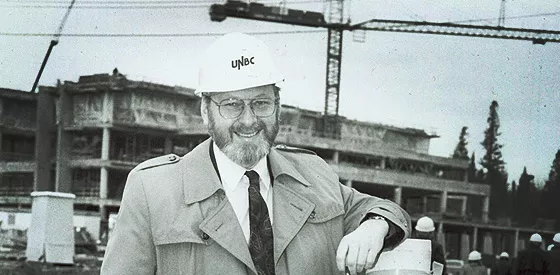
UNBC's first president, Dr. Geoffrey R. Weller.
1991 saw the appointment of the first executive staff, development of the master plan for the Prince George campus, publication of the first Academic Plan, creation of enrolment forecasts, distribution of UNBC newsletters throughout the north, participation in scores of public meetings, planning of a major fundraising campaign, development of proposals for regional operations, and many other items of consolidation.
1992: Sod-Turning, courses begin, and Convocation

UNBC's first student, Amanda Bullock.
1992 saw a return to high-profile developments. In February, the model of the Prince George campus was first unveiled, and in March, members of Convocation elected the University's first Chancellor, Iona Campagnolo. March also, however, saw a setback: it was announced that the full opening of the University would be delayed from September 1993 to September 1994. April saw the official sod-turning ceremony for the Prince George campus, conducted by BC Premier Mike Harcourt. This was followed in May with the largest and most prestigious event in the University's history to date - the Inaugural Convocation Ceremony, at which the formal Installation of the President and Chancellor took place. August saw the registration of the University's first students, when 70 students joined the "QuickStart" program at facilities in Prince George, Terrace, Quesnel, Dawson Creek, and Fort St John. In November, interviews began for the appointment of the first 40 faculty members.
1993: Gearing up for the Opening
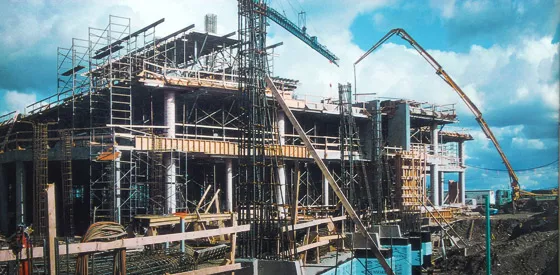
Construction of UNBC's Prince George campus in progress.
February saw an important milestone in the University's endeavours to gain bursaries and scholarships to students: the raising of the first million dollars in the North to the Future campaign. This campaign was established to create a permanent legacy of ten million dollars of government-matchable funds. March saw the conclusion of phase 1 of construction of the Prince George campus. In May, the details of the second year of the "QuickStart" program, which had been greatly expanded, were announced. A major expansion of University staff took place in July, with the intake of some 30 new faculty members. By the fall of 1993, with faculty, officers, and students in place, it was possible to create a Senate, and the Interim Governing Council was thus able to hand over its powers to a Board of Governors and UNBC Senate.
1994: Official Opening
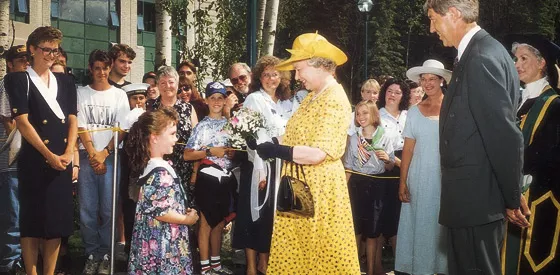
Her Majesty Queen Elizabeth II at the official opening of UNBC.
On August 17, 1994, Her Majesty Queen Elizabeth II visited Prince George to officially open the University. The event attracted upwards of 10,000 people to the campus for the ceremony and events into the evening. Many more watched on television, during a live, nationwide broadcast on CBC. Classes began three weeks later when 1400 students participated in the start of full operations. Interestingly, thanks to the Quickstart program, UNBC produced its first graduates before the campus even opened: 6 students graduated that May.
Within months of the start of full operations, both President Weller and Founding Vice-President Academic Ken Coates announced they would be stepping down. The moves signalled a remarkable shift at UNBC: from construction to operation.
1995: Jago arrives
The search for a new President to replace Geoffrey Weller resulted in the appointment of Charles Jago, who had been principal of Huron College at the University of Western Ontario. Between his arrival and President Weller's departure, the UNBC Board of Governors appointed George Pedersen - a former President of SFU and UBC, as well as a former Vice-President at UVic - to be interim President during the summer. They came to a university that was already demonstrating success in increasing access to northern students: between 1992 and 1994, the number of northern high school graduates going to university nearly doubled.
1996: Character forms
Although it's impossible to attribute to any particular year or event, it started to become very apparent by 1996 that UNBC was a special place, very much in keeping with its founding through grassroots citizen participation. Consider the story of the student whose study on the health and fitness of dogsled mushers was actually delivered to her professor by dogsled. 1996 also saw the first student apply for admission to UNBC via the world wide web.
1997: Program Expansion
An English course became UNBC's first to be delivered entirely over the Internet, signalling a new era in course delivery. 1997 was also the year UNBC began offering its first PhD, in Natural Resources and Environmental Studies, as a well as the Northern Advancement Program, which serves to ease the transition to university for rural and First Nations students. Already by 1997, Prince George was emerging as BC's "university town": as a percentage of the population, there were more people pursuing university-level coursework in Prince George than any other BC municipality.
1998: Thumbs-Up from Maclean's
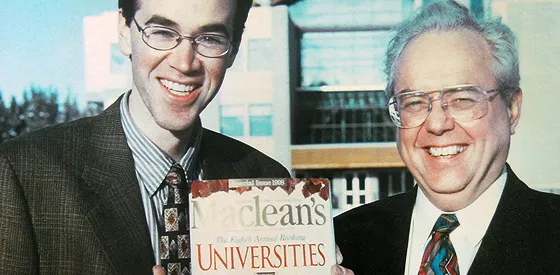
Manager of Communications and Media Relations, Rob van Adrichem and UNBC President, Charles Jago celebrate UNBC's successful rankings in Maclean's Magazine.
Not since the live, televised opening of the campus had UNBC received such important national media coverage as when Maclean's magazine included UNBC in its annual ranking of Canadian universities. UNBC debuted ninth out of 21 universities in Maclean's "primarily undergraduate" category, achieving best-in-category scores for library acquisitions and research. In a survey of 3500 education officials and corporate CEOs that accompanied the ranking, UNBC placed third as a "leader of tomorrow."
1999: Construction again
Forest industry legend Ike Barber participated in a sod-turning ceremony for the I.K. Barber Enhanced Forestry Laboratory, the first academic building to be added to the Prince George campus since the start of full operations in 1994. Barber provided the lead donation for the facility, and joined with West Fraser and Forest Renewal BC to also create UNBC's first two research chairs on forest management topics. UNBC's first research forests were also created.
In November, in front of 1000 fans, UNBC's men's and women's basketball teams began competition in the BC Colleges' Athletic Association and played their home games at the College of New Caledonia.
2000: The Health Decade begins
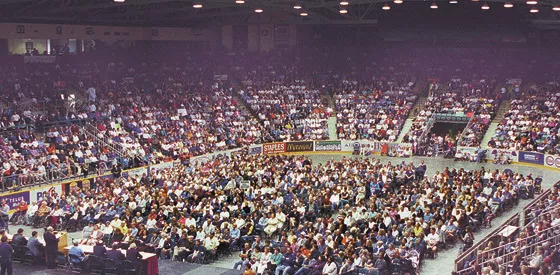
Over 6,000 people at a health care rally in Prince George.
It was a watershed moment for Prince George and UNBC on June 22 (coincidentally the 10th anniversary of the passage of the UNBC Act creating UNBC), when 6000 people packed the Prince George arena to express their frustration over a crisis in local health care delivery. Among the speakers at the rally was President Jago, who suggested that the only way to resolve a shortage of health care professionals was to start training more of them - including physicians - in northern BC. The development of a northern medical program galvanized those in attendance and quickly spread around the region. Four days after the rally, the Prince George Community Foundation established a northern medical education fund to demonstrate grassroots support for medical education. "Remember what the $5 donations to UNBC accomplished. Let's do it again," said the Foundation president, Noreen Rustad.
24 year old James Moore, a fourth-year Political Science student, made history when he became the youngest Member of Parliament in BC's history as a candidate for the Canadian Alliance (now, the Conservative Party).
2001: Time to Grow
Less than seven months after the rally that gave birth to the idea of a northern medical program, UNBC and UBC announced a plan to create one together. The concept was announced a national rural health summit that was being held in Prince George. Government support for medical education expansion in the North became a major topic for the provincial election campaign later that year, with Gordon Campbell's Liberals promising support. The medical program wasn't the only major project at UNBC. The outgoing NDP government was bringing $18 million to build a new laboratory building after UNBC's fledgling science and research programs were bursting at the seams. Construction of the new lab, and the Bentley Centre that connects the lab to the Agora, began that summer. UNBC's growth in research was further acknowledged when the University received two federally funded Canada Research Chairs in the program's first year, a feat matched by only one other small university.
While UNBC was growing, it was also playing a greater international role. It was one of the founders of the University of Arctic in 2001, a unique partnership involving institutions in Canada, the US, Scandinavia, and Russia to increase educational opportunities for northern peoples.
2002: NMP confirmed, and more
By spring, Government support for the Northern Medical Program had been obtained, with funding confirmed both for the program expansion with UBC as well as for a new $12 million facility at the Prince George campus. Building on the initial grassroots support initiated by the PG Community Foundation, a Northern Medical Programs Trust was established, with communities around northern BC pledging to raise money (with the amounts based on their populations) in support of the program and its future students. Tumbler Ridge was the first to complete its pledge, contributing $65,000 to the Trust.
Medicine wasn't the only new program, however. 2002 saw the addition of new bachelor's degrees in Education and Environmental Engineering, as well as a graduate degree in Disability Management that was unique in Canada. Along with the promise of new programs, however, came increased tuition fees. That year, they rose 22% after a prolonged tuition fee freeze in BC.
2003: Faster, higher, stronger
Tuition fees increased even more in 2003, rising 33%. At the same time, UNBC was adding facilities and programs designed to make it more attractive. Part of this included an $10 million expansion to the laboratory that had just been completed the previous year. Together with construction of the Northern Health Sciences Centre which was also underway, the northern part of the campus was poised for a makeover. But an even larger facility was rapidly coming into view. That summer, several hundred local residents attended an event at UNBC to watch the selection of Vancouver as the 2010 Olympic host city. It was part of local efforts to secure value from the Games and the idea of a Northern Sport Centre at UNBC was Prince George's top legacy project.
2004: 10 years of full operations
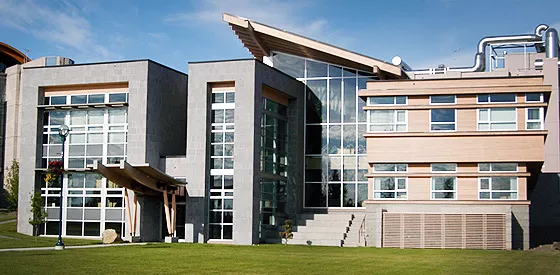
The Northern Health Sciences Centre, home of the Northern Medical Program.
A decade after The Queen came to open the Prince George campus and kick-start full operations for UNBC, the total number of alumni (more than 4200) had finally surpassed the number of current students (about 3700). First Nations students made up about 10% of the student body, one of the highest percentages in Canada.
The first decade was also marked by a special convocation ceremony on August 17 to present honorary degrees to 10 key founders, including former premiers Mike Harcourt and Bill Vanderzalm. On the same day, the Northern Health Sciences Centre was officially opened, featuring the inaugural class of Northern Medical Program students who would be the first to occupy the building.
The year ended with timely validation from Maclean's, which, in 2004 for the first time, named UNBC the best small university in western Canada.
2005: Hard hats and steel-toed boots
One decade of full operations seemed like the logical time to assess the economic impact of the University. The City's economic development unit - Initiatives Prince George - led the study, which concluded that the local economic impact of both the college and university topped $700 million annually. Surely construction was a major and visible component of economic impact. With the Northern Health Sciences Centre and Lab expansion recently completed, the Government of BC made two further announcements: in February, $32 million was provided to build a new Teaching and Learning Centre, and the following month, $20 million was contributed to the construction of the Northern Sport Centre. In addition to the new construction, the Bank of Montreal donated its former branch to the University to serve as UNBC's first downtown campus.
2005 was also a banner year for fundraising with Don Rix making the largest single contribution in UNBC history - $3 million - to support the Northern Health Sciences Centre (which now bears his name) and the creation of a new research chair in Aboriginal Environmental Health.
2006: Jago steps down (for now)
After 11 years at the helm of UNBC, President Charles Jago stepped down in 2006, only a few weeks after construction began for the Sport Centre, which now bears his name. He was replaced by Don Cozzetto, who grew up in the Kootenay region of BC and had been a university professor and administrator in the United States. During his first month as President, the Government of BC doubled UNBC's Prince George campus grounds, providing crown land adjacent to the campus to the University. At the same time, expansion was occurring in regional centres: a magnificent campus in Quesnel opened in 2006 and the Government provided $1 million to acquire a campus in Terrace.
2007: Financial Challenges Emerge
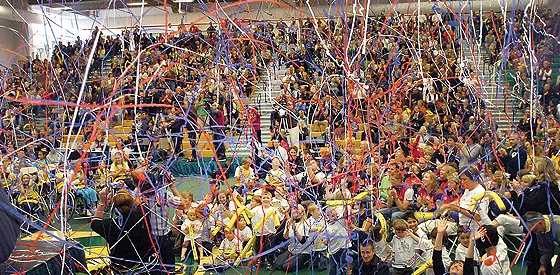
Celebrations at the opening of the Northern Sport Centre.
Faced with relatively static enrolments and rising costs, the Board of Governors approved a plan to shave $6 million from the operating budget over three years by cutting some faculty and staff positions. Nevertheless, financial support arrived from other places: a $2 million anonymous gift, for example, completed the original $6 million goal for the Northern Medical Programs Trust and the Northern Development Initiatives Trust provided critical funding to construct the Northern Sport Centre. Research was also becoming nationally recognized with a 90% increase in funding over the previous year.
The Olympic-like opening of the Sport Centre that September was the cornerstone for UNBC's first alumni homecoming and subsequent sold-out home openers for the men's and women's basketball teams.
2008: A year of milestones; Jago returns
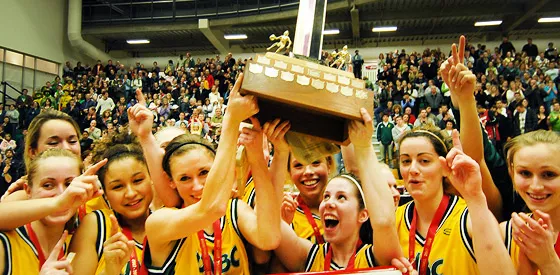
Women's basketball team wins provincial championship.
The first season in the Sport Centre culminated with the women's basketball team winning the provincial championship - at home - for the first time. It was the first of a number of highlights and accolades in 2008: best-ever ranking (2nd) in Maclean's, a "research university of the year" in the National Post, and the awarding of $11 million from the federal government to fund the largest research project in UNBC history; a study of the effects of environmental contaminants in northern communities. In fact, even before this project was announced, UNBC had reached a milestone in 2008 of receiving $100 million in research funding to date.
2008 also saw UNBC trademark the phrase Canada's Green University. The first annual UNBC Green Day was held that year, along with the first investment, from the Government of BC, for a campus-wide bioenergy system at UNBC.
After two years as President, Don Cozzetto resigned and was replaced on an interim basis by Charles Jago.
2009: George Iwama arrives as UNBC President
George Iwama, the first university president in Canada of Japanese ancestry, arrived at UNBC from Carleton University but he had seen his academic career reach from coast to coast. He started his job as UNBC's fifth president on July 1. Literally the day before, UNBC opened a wood pellet system at the I.K. Barber Enhanced Forestry Lab, the first University-owned-and-operated bioenergy system in Canada. The experience prompted the University to explore renewable energy for the rest of the campus and $22 million in federal and provincial funding was announced for a campus bioenergy system.
2010: First place....with Harvard
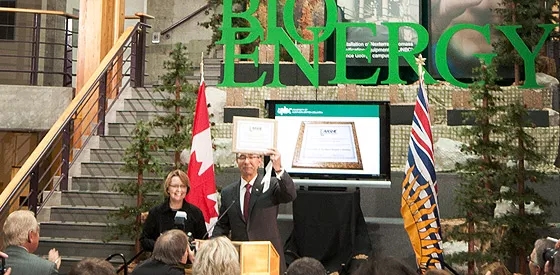
UNBC shares the top campus sustainability award in North America with Harvard University.
The growing bioenergy project - and its connections with teaching, research, communities, and the local forest industry - earned UNBC the top campus sustainability award in North America, from the world's largest college/university "green" association. In fact, UNBC shared the first-place award with Harvard University. This wasn't UNBC's only accolade in 2010: the men's basketball team captured UNBC's first national championship, with UNBC's Inderbir Gill named the national athlete of the year across all sports. Other national recognition was received by professor Margo Greenwood, recipient of one of only 14 national aboriginal achievement awards after being named BC academic of the year earlier in 2010. UNBC was also named tops among small universities in a national research survey. The survey measured number of faculty, their research earnings, and their publishing success with UNBC achieving the best score of any university outside of Ontario.
UNBC Business students hosted the largest student competition ever held in Prince George, when they hosted the western business games (JDC West) and posted two first-place results for UNBC's first time in the competition.
2011: Wood Innovation
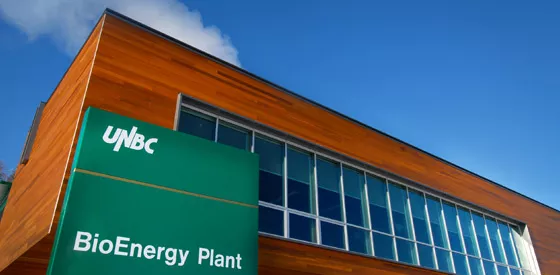
Students continued having successes in 2011: Randi Woodbeck of Houston became the first northerner to receive the most prestigious studentship from the BC Cancer Agency, PhD student Geoff de Ruiter won the community energy challenge at the International Student Energy Summit, and Computer Science student Jake Edwards won best paper awards at international conferences in Jordan and Singapore.
Less than one week after being sworn in, Premier Christy Clark joined MP Dick Harris to officially open the University's Bioenergy Plant, which uses local sawmill residue to reduce UNBC's use of fossil fuel for campus heating by 85%. Within a few months, third-party testing revealed the emissions from the Plant to be lower than natural gas, making it one of the cleanest bioenergy plants in North America.
Continued support for innovation with wood led to a Government announcement later in the year that it would construct a Wood Innovation Centre in downtown Prince George that would also house an expansion of UNBC engineering programs.
2012: A great place to work, too
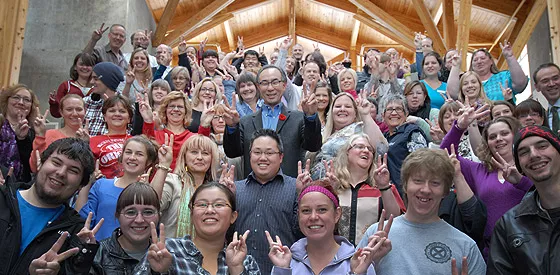
UNBC students, staff, faculty and administrators gather with President Iwama to celebrate UNBC's 2nd place ranking in Maclean's.
After years of seeing students and faculty win prestigious awards, UNBC won its first awards in 2012 related to its excellence as a place to work. UNBC was one of only three employers outside of the Lower Mainland to be named one of BC Top 100 employers and then became one of only four universities to be named one of Canada's 50 greenest employers. Not to be outdone, students and faculty still garnered their share of provincial and national accolades. For example, Cameron Bell and Selena Demenoff were two of 10 students nationwide to receive the inaugural 3M national student fellowships. They were the only recipients from western Canada.
Both men's and women's basketball teams won the provincial championship in their last year as members of the BC college league. 2012 marks their debut - along with the men's and women's soccer teams - as members of the Canada West conference of Canadian Interuniversity Sport.